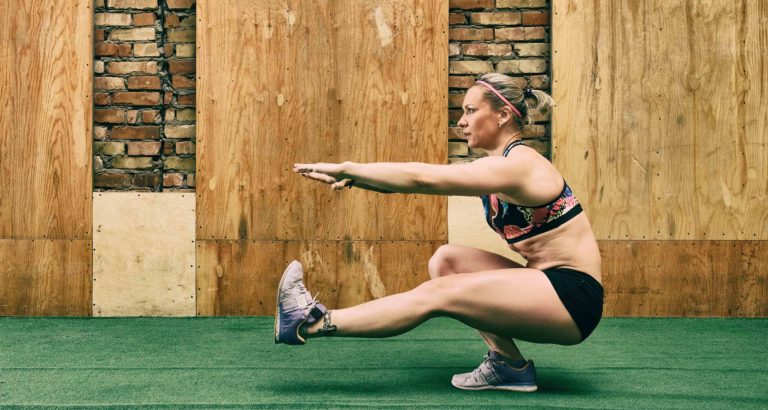Movement Quality First

Movement Quality
There are two primary questions I urge you to ask yourself regarding any aspect of your fitness and performance enhancement program:
Am I able to perform the movement, exercise, or activity with the proper technique, mechanics, and form?
Is the movement, exercise, or activity I am performing painful?
How does poor technique impact my fitness and performance enhancement program?
There are certain specific pre-requisites that many movement patterns possess in order to be considered safe and overall effective. These prerequisites often revolve around adequate mobility/flexibility as well as safe and efficient form.
Impairments in movement quality have the potential to place excessive stress onto unintended regions of your body while not properly utilizing the intended regions of your body. This may lead to an imbalance where the over-stressed regions experience pain and injury, while the under-utilized regions lack the benefits from exercise and fitness resulting in reduced overall performance.
How does pain impact my fitness and performance enhancement program?
The presence of pain during an activity indicates that adjustments may need to be made to your fitness and performance enhancement program.
There is a phenomenon that has since been confirmed by scientific research, demonstrating:
The presence of pain has the ability to alter motor/movement control in unpredictable ways.
What does that mean? If pain is present during a movement, no one can reliably, consistently, or accurately predict how that movement will be performed. And the worst part is, you may not feel or notice these changes or alterations in movement quality.
So in other words:
- It is unpredictable WHICH muscles are going to be working to perform the desired movements and activities
- It is unpredictable HOW those muscles that are involved in the desired movements and activities will work and function.
For example, when pain is present it is not uncommon to find that:
a.) A core exercise may not strengthen the Abs but rather stress the low back.
b.) A Glute exercise may not strengthen or target the Glutes, but rather the Hamstrings or Quadriceps.
c.) A Hamstrings exercise may not strengthen or target the Hamstrings, but rather the Quadriceps.
d.) A chest exercise may not strengthen or target the Pecs, but rather the anterior Deltoids while stressing the Rotator Cuff.
No one can say for sure why these changes in movement quality occur during painful activity; however there are a few theories on the subject.
One of the more supported theories state that it may be a protective mechanism that your body attempts to subconsciously implement in order to avoid further stress on the injured area. However the result is often more harm than good. The compensations often result in excessive stress on other surrounding structures potentially leading to an overall larger injury.
So what is the take-away on the relationship between movement and pain?
Pain in the presence of your fitness program indicates that your efforts would be better served focusing on restoration and recovery of that pain rather than attempting to “train through it.” That is because pain has an ability to affect the way you move in unpredictable ways, often including which muscles you are using during an exercise.
Therefore, you may very well be performing a highly effective training program but not seeing any results simply because pain is preventing the exercises from working the way they were designed to work.
Summary
As you begin the process of improving your fitness, the initial priority must always be placed on movement quality. That is because movement quality is the base upon which your fitness is built.
Please recall, movement quality includes pain free flexibility, mobility, stability, motor control, and technique. Essentially, it is the skill and ability to perform a movement or activity appropriately.
Without this pre-requisite, the remainder of your fitness development and performance enhancement program becomes UNPREDICTABLE, not optimally effective, and potentially susceptible to causing injury.
However as soon as movement quality is no longer a limiting factor, you will be able to wreak the full and unrestricted benefits of strength, endurance, and speed training!

Dr. Eugene Ketselman PT, DPT, Cert. MDT, CSCS
Dr. Eugene Ketselman is a licensed Physical Therapist, Certified Strength and Conditioning Specialist, Performance Coach, and owner of Convergent Movement and Performance; Home of where Physical Therapy, fitness, and performance training converge! Dr. Ketselman's mission is to help motivated athletes and active adults excel in their passions by maximizing physical performance and reducing setbacks from pain and injury.
Here at Convergent Movement and Performance, we practice what we preach. You know we are a good match for one another as soon as you find yourself relating to the content we provide. Be sure to click below to learn more.
Do you have specific questions that aren’t answered on this website?
Click below
Does pain, weakness, or exhaustion prevent you from reaching your FULL potential while performing the activities you love?
Click below
Do you love what you’re seeing, but still aren’t sure if you can make the commitment?
Click below
Contact Us
Convergent Movement and Performance serves out of Northern – Central New Jersey, conveniently located to those that live, work, and travel in the nearby towns of Warren, Bridgewater, Martinsville, Watchung Hills, Bedminster, Basking Ridge, Bernardsville, Chatham, Westfield, and Piscataway within Somerset, Morris, Union, and Middlesex counties, NJ.
